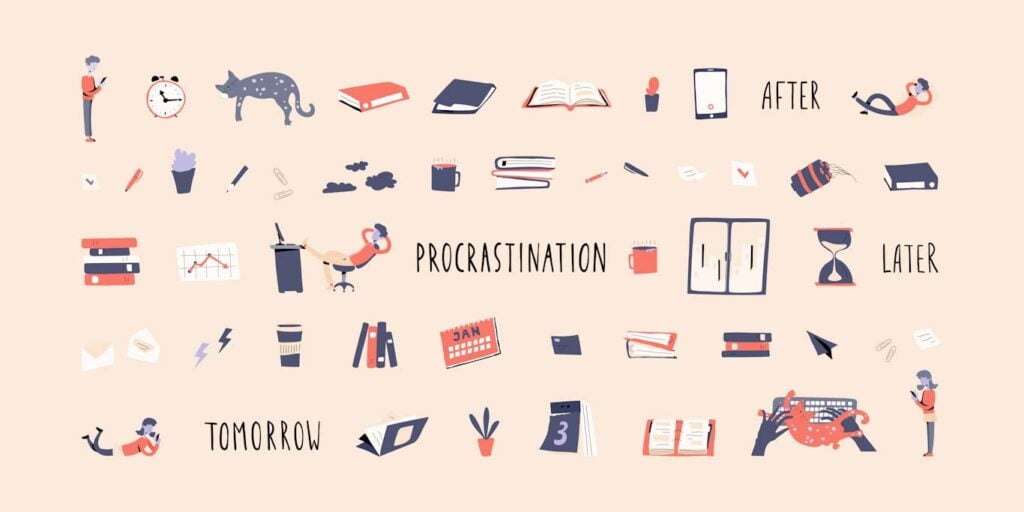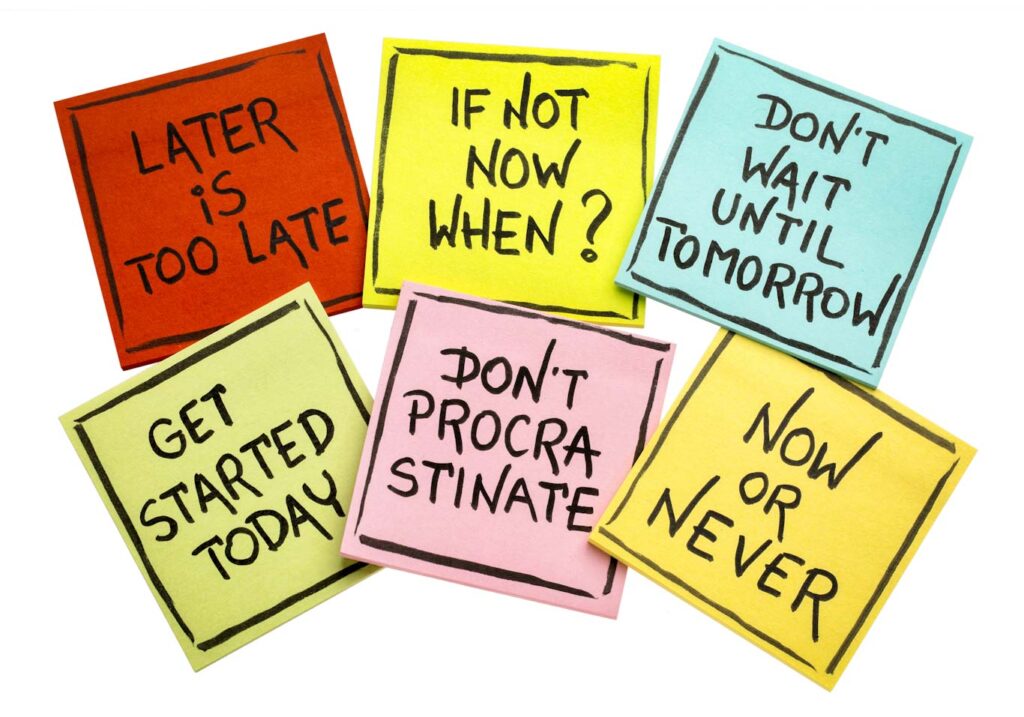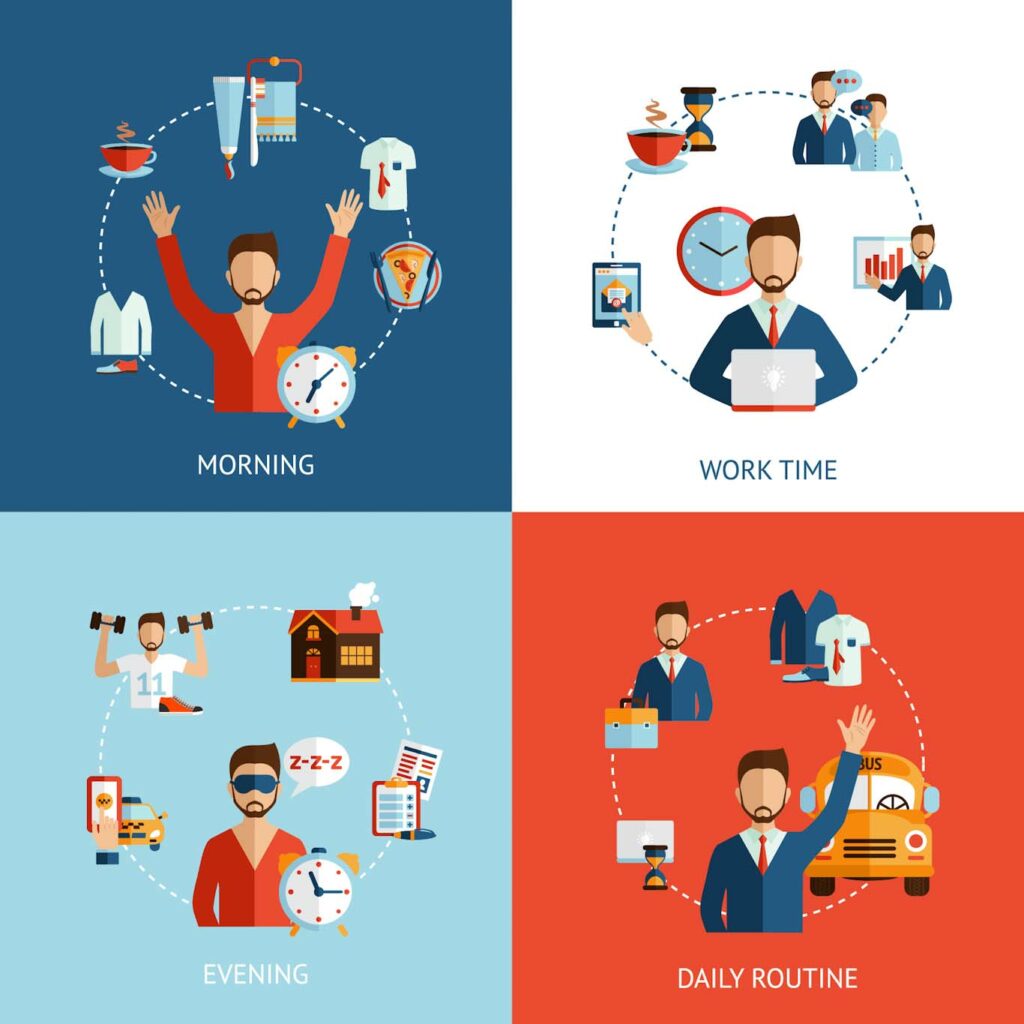
You know you’re supposed to work on a project. However, instead of getting started, you loaf around your inbox and social media apps. You simply don’t feel like doing anything. So how can you avoid procrastination as a remote worker?
Well, it starts with the simple thought that you still have time. You put off important tasks and wait until it is too late. When you’re approaching the deadline, you start to panic and wish that you had more time— which you would have had, if you hadn’t been procrastinating.
Any responsible employee aims to become productive and efficient at their job. Despite putting off their tasks, people still sincerely want to learn how to stop procrastinating. In this post, we are going to show you how to overcome this procrastination problem by dealing with the root cause.
TL:DR – How to Stop Procrastinating
Find the Root Cause of the Issue: Determine the factors that cause you to delay your tasks. Solving the problem requires introspection and complete honesty.
Break Tasks into Smaller Chunks: To avoid getting overwhelmed by bigger projects, break them into smaller and actionable tasks. This requires more discipline but makes the tasks more manageable. Be specific with the tasks you add to your to-do list.
Observe Your Work Behavior: Make note of your workflow cycles and schedule challenging tasks at your peak times.
Create a Work Routine: With your workflow cycles analyzed, create a daily routine that works best for you.
Build Self-Compassion: Don’t beat yourself up for procrastinating. Practice self-kindness to bounce back from setbacks, reduce negative feelings, and stay motivated.
Use Strategies for Managing Time: Try the Pomodoro Technique which lets you organize your workflow. For every 25 minutes of work, you will take a 5-minute break.
Boost Your Energy: Keep yourself hydrated, get enough sleep, eat healthy, and exercise.
Develop Self-Control Through Awareness: Notice what triggers your urge to delay. Tools like Traqq help you track habits and understand when your focus drifts—making it easier to stay on task.
Avoid Setting Expectations That Are Unrealistic: Perfect is the enemy of good. Start small, even if it’s just one sentence or task. Momentum builds as you go.
Eliminate Distractions: Identify and reduce time-wasting habits—like watching TV or aimless browsing. Use app tracking with Traqq to pinpoint where your time is really going.
Focus on the “Why”: Connect your task to a larger goal. Knowing the purpose behind your work makes it easier to start and follow through.
Redesign Your Environment: Make procrastination harder and progress easier. Simple tweaks—like signing out of social apps or setting a weekly review in Traqq—can keep you on track.
Don’t Wait to Feel Ready: Start before you feel 100% motivated. Action leads to momentum, which leads to success. Start now—even if it’s small.
Procrastination Definition

Psychology professors discuss what it means to procrastinate:
Procrastination is a form of self-regulation failure characterized by the irrational delay of tasks despite potentially negative consequences.
Despite knowing the consequences of procrastination, an individual still delays their tasks until the last minute, or even past the deadline, basically due to underlying anxiety.
How Common Is Procrastination?
DePaul University professor Joseph Ferrari said that around 20% of adults in America still engage in chronic procrastination, which is a common issue for most people. Students are the common subjects of studies related to this behavior. However, considering the current economic climate, we must look at how the workforce is faring in this area.
Writer and entrepreneur Darius Foroux conducted an online survey through his newsletter. When the data was collated, he learned that out of the 2,219 participants, 88% admitted that they procrastinate for at least an hour daily. 34.6% said that they put off tasks for 2 to 3 hours, while 16.2% said they do the same for 3-4 hours.

Why do workers procrastinate? Well, Ferrari mentioned this behavior has to do with irrational beliefs, low self-esteem, depression, and fear of failure, among other things. For many, it is a self-protective strategy. In case a person fails, they’d use “not trying” as an excuse for the result. Unfortunately, the effects of procrastination are bigger than the stress they’ve been avoiding.
How to Overcome Procrastination
If you want to reduce or eliminate procrastination, you must establish your goals. Then, think of how delaying your tasks will prevent you from achieving them. In the following sections, we will show you some of the most effective strategies for overcoming procrastination.
Determine the Root Cause of the Issue
You may wonder, “Why can’t I stop procrastinating?” Well, to gain a deeper understanding of this behavior, you must look into the nature of the problem. Here are three factors to consider when assessing your behavior:
When: Ask yourself what particular situations cause you to delay your tasks. During what time of the day are you unproductive? At what point do you start struggling to complete your tasks?
How: Determine what you do whenever you procrastinate. Do you turn your attention to other activities like browsing the news, posting on social media, or playing video games?
Why: Ask yourself what’s causing you to put off your tasks. Do you find yourself overwhelmed with the difficulty of the job? Do you seem to get distracted often?
Keep in mind that there are many reasons why people procrastinate. For some, it has to do with the lack of motivation, especially when they know that rewards are far in the future. Individuals with polarized thinking tend to put off tasks because they fear failure or they are too obsessed with perfectionism. So, at the start of your journey, you have to introspect and determine why you procrastinate.
Break Tasks into Smaller Chunks
If you procrastinate because you feel overwhelmed with big projects, take some time to break them into smaller tasks. Each small task will be more manageable and less intimidating. Let’s say you’re organizing an annual conference. Instead of looking at it on a grander scale, create a to-do list that consists of smaller and immediately actionable items. For instance, you can start by asking for quotes from local hotels or researching appropriate keynote speakers.
Also, when you create your to-do list, it’s advisable to start with a clear action verb—as if you were giving yourself directions. Some examples can include, “contact possible keynote speakers,” “research best caterers in the area,” and “submit the budget proposal to executives.” Also, avoid using vague words like “plan” or “organize.” When you become more specific with your tasks, it will be easier for you to take action.
Observe Your Work Behavior
We all have our own productivity cycles, with some feeling more productive in the early morning and others during the wee hours of the night. So, one of the best ways of learning how to avoid procrastination is by determining your peak times. Observe your behavior and determine the times of the day when you feel most productive. Then, organize your tasks, ensuring that you do most of the work during the hours that you can power through your work.

You must also determine your slump times, or the hours when you are least productive. Make sure that the easy and simple tasks are scheduled for those periods. Now, if you don’t know how to determine or analyze your productivity cycles, we recommend that you use Traqq. Aside from functioning as a time tracker, this tool also works as a productivity monitoring app. On the dashboard, you will see your activity levels throughout the day. You can easily see your peak and slump times, because high activity levels are coded in green, normal levels in yellow, and low levels in red.
Create a Work Routine

One of the ways to stop yourself from procrastinating is by establishing a consistent work routine. For instance, if you feel most productive during the morning, start your day by doing your most important tasks. By working on the most complicated items while you still have a clear head, you’re able to achieve more. Avoid working from your bed as it can create an environment that fosters procrastination.
Remember to take your productivity cycles into account when establishing your daily routine. Just because your colleague says that jogging during their lunch break helps them power through tasks, it doesn’t mean that it will work for you. If you usually feel tired after running, you may want to put off exercising till the end of the day when you’re done with work. A study conducted by psychology experts in Germany revealed that establishing a routine is especially helpful for people with erratic sleep schedules. After all, when a person is sleep-deprived, they are more prone to procrastinating.
Build Self Compassion to Boost Productivity
Self-compassion plays a crucial role in productivity by allowing individuals to acknowledge and accept their mistakes without dwelling on negative feelings. Self-compassion helps develop a growth mindset, focusing on progress rather than perfection, which is essential for overcoming procrastination.
When individuals treat themselves with kindness and understanding, they reduce stress and anxiety, making it easier to stay focused and avoid procrastination. Self-compassion fosters a more realistic sense of one’s abilities and limitations, enabling the setting of achievable goals and reducing the likelihood of procrastination.
By staying present and focused on the current moment, rather than worrying about past mistakes or future uncertainties, individuals can more effectively overcome procrastination. Self-compassion also enhances self-awareness, helping individuals recognize their thoughts, feelings, and behaviors, which is crucial for spotting and overcoming procrastination habits.
Prioritizing self-care and self-compassion improves overall well-being and productivity. It helps individuals stay resilient in the face of failure or setbacks, making it easier to bounce back and continue working towards their goals. This resilience reduces the likelihood of procrastination and fosters a more positive and supportive inner dialogue, which is essential for staying motivated and focused.
Practicing self-compassion not only enhances effectiveness but also makes it easier to overcome procrastination by fostering a positive mindset, reducing stress, and promoting a realistic and supportive approach to personal and professional challenges.
Use Strategies for Managing Time
There are plenty of time management techniques that will make it easier for you to get your work started and manage your time wisely. For instance, you can try the Pomodoro Technique which will help you organize your workflow. With this method, you work on your tasks for a pre-determined period (i.e. 25 minutes). Once that period is over, you will take a short break (i.e. 5 minutes). Once the break is over, you will start the cycle again. You can also take a longer break when you’ve completed a specific number of cycles.
Get Rid of Procrastination Pit-Stops
If you find yourself delaying your tasks, then perhaps it’s because you’re making it easy to procrastinate. In this case, you must establish the apps and websites that eat up your time. If you are unaware of what your procrastination pit-stops are, we recommend using Traqq. This tool will also monitor the apps you use and the websites you visit.
When you go to the dashboard, you will see a pie chart that illustrates what you spend the biggest chunks of your time on. So, if you’re loafing around news websites, you can easily identify this through Traqq. In most cases, the best way you can learn how to not procrastinate is by sparing yourself from the distractions and actively working to eliminate distractions.
Boost Your Energy

One of the best ways to pull yourself out of the slumps is by increasing your energy level. Remember that when you’re tired, you’re more prone to procrastinate. Here are some tips to get started:
Keep yourself hydrated—Your concentration at work can be affected when you’re dehydrated. The good news is, you can easily solve this problem by drinking a glass of water. You can also drink other beverages but do so in moderation. For instance, if you consume too much sugar or caffeine, your energy levels may crash within a few minutes or hours.
Get adequate sleep—As we’ve mentioned, sleep deprivation is one of the reasons why some people are prone to procrastinating. Part of establishing a work routine is making sure that you also have enough sleep. By scheduling your sleep, you are also improving other aspects of your life, including your physical and mental health.
Eat healthy—It’s hard to get to work when you hear your stomach grumbling. So, when you feel hungry, eat something to increase your strength. Also, remember to avoid eating junk food as it will only give you an energy spike for a short while, but then make you feel tired immediately. Instead, research about foods that boost brain power, concentration, and focus.
Exercise—Try to get your body moving, especially if you’ve been sitting for several hours in front of your computer. You don’t have to do anything complicated like lifting weights or performing circuit training. Sometimes, all it takes for you to feel better is a bit of stretching or some breathing exercises.
Rest—Ensure you take adequate rest to recharge and maintain your energy levels throughout the day.
Build Self-Control Through Awareness and Intention
When learning how to avoid procrastination, one of the most effective skills you can develop is self control. This doesn’t mean forcing yourself to grind through important tasks with sheer willpower. Instead, it’s about becoming aware of your impulses and creating systems that support your goals.
Let’s say you tend to push off school work, or you avoid writing that project report until the last possible minute. In these moments, notice the urge to procrastinate. What are you thinking? Are you feeling overwhelmed, frustrated, or even afraid of making mistakes? These reactions are natural, but when left unchecked, they often spiral into negative habits—like watching TV, scrolling social media, or daydreaming about what you’ll do “tomorrow.”
This is where self-awareness tools can help. For example, Traqq doesn’t just function as a time management tool—it also acts as a digital mirror. By logging your time spent on various activities and visualizing your habits, Traqq helps you identify when and where your focus drifts. Seeing these patterns makes it easier to course-correct in real time.
Over time, this awareness supports the development of better habits, allowing you to gently redirect your focus to what matters most.
Avoid Unrealistic Expectations
Many people procrastinate because they set unrealistic expectations for themselves. Maybe you believe that unless you can do something perfectly, there’s no point in starting. Or maybe you assume you’ll be able to complete a big task in a certain amount of time without accounting for distractions or negative feelings.
These beliefs can trigger a cycle of avoidance. You plan to begin a project, but then feel unprepared or overwhelmed. As the deadline approaches, your anxiety builds and you feel bad for not starting sooner. You begin to fear failure and push the task off, telling yourself you’ll “have more time” or “be in the right headspace” then.
The solution? Start small. Break down what feels huge into a list of tasks you can actually complete, even if it’s just opening a document, or writing one sentence. That’s progress. One small example: If you’re working on a long article, just write the headline today. Tomorrow, outline the structure. Momentum builds when the steps are easy enough to begin without resistance.
Understand Your Triggers and Eliminate Distractions
If you want to change your habits, it’s essential to understand your procrastination triggers. For many people, these include fatigue, boredom, or low motivation. Other common pitfalls are environmental: family members talking in the background, multiple browser tabs open, or frequent pings from messaging apps.
Using Traqq, you can track how much time you’re losing to these distractions. The activity dashboard reveals how much time was spent on productive versus non-work-related apps. With this data, it’s easier to take targeted action—such as muting notifications, setting app limits, or even blocking certain websites during work hours.
You can also try the Pomodoro Technique or time-blocking, two proven time management techniques that help minimize distractions while maximizing focus. These methods not only organize your day—they also make it easier to stay on task when your motivation dips.
Focus on the “Why” Behind the Task
If you’re procrastinating regularly and feeling frustrated, ask yourself: “Why does this task even matter?” People are far more likely to succeed when they can connect their daily work to a larger purpose.
For instance, completing a report may feel tedious in the moment—but it could be the most critical thing that week because it contributes to a larger goal, like landing a new client or advancing your career. It’s easier to find the motivation to follow through when you align the task with a real reward: progress, recognition, and growth.
This sense of purpose can shift your mindset from “I have to do this” to “I choose to do this because it brings me closer to something that matters.”
Address the Emotional Side of Procrastination
Procrastination is rarely about laziness. More often, it stems from deeper emotional states—anxiety, fear, lack of confidence, or even burnout. You might procrastinate not because the task is hard, but because it feels like it says something about your worth if you fail.
This is why practicing self compassion is so crucial. When you make a mistake or miss a deadline, avoid harsh self-talk. Instead, remind yourself: “I’m doing my best, and I can try again.” This shift can help you bounce back instead of spiraling further into avoidance.
Feeling bad doesn’t improve performance—it delays it. So, rather than letting negative feelings define your workday, create space for self-kindness. Take breaks. Talk to someone. Do a quick reset walk. These aren’t indulgent, but rather effective ways to regulate your emotional state so you can stay productive.
Make Procrastination Harder (and Progress Easier)
The easiest way to change a habit is to redesign your environment. Make procrastination more difficult and progress more convenient.
This could mean:
Logging out of social media accounts.
Setting up a dedicated workspace.
Using Traqq’s idle time detection to gently prompt you back to work.
Starting each week with a prioritized list of the most important things to focus on.
You can even use Traqq to schedule regular reviews—maybe once a week—where you look at how your time was spent and decide what to improve. That little check-in, done consistently, builds accountability and supports your success.
Don’t Wait for the Perfect Time to Begin
Many people delay work because they’re waiting for inspiration to strike or for the “perfect moment.” But real progression starts when you choose to start, even if things aren’t ideal.
Remember, action leads to motivation—not the other way around. If you wait until you “feel like it,” you may never start. But if you take one small action, you create momentum. It’s a signal to your brain that this task is safe, doable, and even rewarding.
And if you don’t finish today? That’s okay. Simply begin again the next day.
Final Thoughts: How Can You Avoid Procrastination?
Avoiding procrastination is not about becoming superhuman. It’s about creating systems that support your thinking, energy, and focus. Whether you’re juggling school work, managing a life full of responsibilities, or trying to finish a major course material deadline, you don’t have to suffer through it all alone.
Tools like Traqq provide clear data that guide your next steps—so you can identify problems early, stay focused on what matters, and build habits that help you succeed.
Remember: It’s not about being perfect. It’s about showing up consistently, making thoughtful decisions, and using the right tools to eliminate distractions and manage your time wisely.

